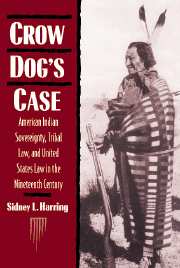 Crow Dog's Case
Crow Dog's Case Book contents
- Frontmatter
- Contents
- Acknowledgments
- 1 “This high pretension of savage sovereignty”
- 2 Corn Tassel: state and federal conflict over tribal sovereignty
- 3 U.S. Indian law and the Indian nations: the Creek Nation, 1870–1900
- 4 Crow Dog's case
- 5 Imposed law and forced assimilation: the legal impact of the Major Crimes Act and the Kagama decision
- 6 Sitting Bull and Clapox: the application of BIA law to Indians outside of the Major Crimes Act
- 7 The struggle for tribal sovereignty in Alaska, 1867–1900
- 8 The legal structuring of violence: U.S. law and the Indian wars
- 9 Conclusion
- Index
3 - U.S. Indian law and the Indian nations: the Creek Nation, 1870–1900
Published online by Cambridge University Press: 23 September 2009
- Frontmatter
- Contents
- Acknowledgments
- 1 “This high pretension of savage sovereignty”
- 2 Corn Tassel: state and federal conflict over tribal sovereignty
- 3 U.S. Indian law and the Indian nations: the Creek Nation, 1870–1900
- 4 Crow Dog's case
- 5 Imposed law and forced assimilation: the legal impact of the Major Crimes Act and the Kagama decision
- 6 Sitting Bull and Clapox: the application of BIA law to Indians outside of the Major Crimes Act
- 7 The struggle for tribal sovereignty in Alaska, 1867–1900
- 8 The legal structuring of violence: U.S. law and the Indian wars
- 9 Conclusion
- Index
Summary
The contradiction between tribal sovereignty and a colonial model of imposed law was nowhere more publicly debated than in U.S. policy toward the Indian nations in eastern Oklahoma. The Cherokee, Creek, Choctaw, Chickasaw, and Seminole – the Five Civilized Tribes – all had purchased their lands in fee simple from the government of the United States in the 1830s (1850s in the case of the Seminole) as a part of complex treaty negotiations accompanying the surrender of their southeastern lands. Even Andrew Jackson had argued that only by moving beyond the boundaries of the United States to the Indian Territory could the tribes be “perpetuated as Nations and enjoy the right of living under their own law.” The tribes' right to maintain their own laws forever was deeply embedded in the consciousness of the Indian people, who all knew by the time of removal that only through strong defense of their traditions would they survive.
All of these tribes, following the Cherokee model, constituted themselves as “nations” in the West, and that usage became common in the white press and in government relations with them. The question of tribal sovereignty that later emerged in Crow Dog had already been settled in these Indian nations. The state's greed for tribal lands and Andrew Jackson's “Indian removal” policy therefore indirectly reinforced mid-nineteenth-century tribal sovereignty in three ways: first, the Five Civilized Tribes, as well as other eastern tribes, acquired political experience in dealing with the United States that they used as the theoretical foundation for their nations in the West, not only calling themselves “nations” but getting treaties from the United States that recognized that status.
- Type
- Chapter
- Information
- Crow Dog's CaseAmerican Indian Sovereignty, Tribal Law, and United States Law in the Nineteenth Century, pp. 57 - 99Publisher: Cambridge University PressPrint publication year: 1994
